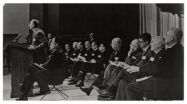(Press-News.org) Japanese honeybees face a formidable foe in the Asian giant hornet, a fierce predator that can reach 40mm long or larger, but the bees have developed a novel defense mechanism: they create a "hot defensive bee ball," swarming around the hornet and literally cooking it.
Now, a new study published Mar. 14 in the open access journal PLoS ONE uncovers some of the neural activity that underlies this unusual behavior, which is not practiced by the Japanese honeybee's European relative.
The researchers, including Takeo Kubo of the University of Tokyo and Masato Ono of Tamagawa University, actually sampled honeybees as they were engaged in a hot defensive bee ball, plucking them off the ball at different time points to investigate the brain function behind this unique adaptive behavior. Using a novel marker gene to detect the neural activity evoked in the brains of the honeybees that form the bee ball, they found that neurons that make up the higher brain center are active while the bees are part of the hot ball. This neural activity differs from that seen in European honeybees.
INFORMATION:
Citation: Ugajin A, Kiya T, Kunieda T, Ono M, Yoshida T, et al. (2012) Detection of Neural Activity in the Brains of Japanese Honeybee Workers during the Formation of a ''Hot Defensive Bee Ball''. PLoS ONE 7(3): e32902. doi:10.1371/journal.pone.0032902
Financial Disclosure: This work was supported in part by the Grant-in-Aid for Scientific Research (B) and Grant-in-Aid for Scientific Research on Innovative Areas ''Systems Molecular Ethology'' from the Ministry of Education, Culture, Sports, Science and Technology (MEXT) of Japan. The funders had no role in study design, data collection and analysis, decision to publish, or preparation of the manuscript. No additional external funding was received for this study.
Competing Interest Statement: The authors have declared that no competing interests exist.
Disclaimer: This press release refers to upcoming articles in PLoS ONE. The releases have been provided by the article authors and/or journal staff. Any opinions expressed in these are the personal views of the contributors, and do not necessarily represent the views or policies of PLoS. PLoS expressly disclaims any and all warranties and liability in connection with the information found in the release and article and your use of such information.
About PLoS ONE
PLoS ONE is the first journal of primary research from all areas of science to employ a combination of peer review and post-publication rating and commenting, to maximize the impact of every report it publishes. PLoS ONE is published by the Public Library of Science (PLoS), the open-access publisher whose goal is to make the world's scientific and medical literature a public resource.
All works published in PLoS ONE are Open Access. Everything is immediately available—to read, download, redistribute, include in databases and otherwise use—without cost to anyone, anywhere, subject only to the condition that the original authors and source are properly attributed. For more information about PLoS ONE relevant to journalists, bloggers and press officers, including details of our press release process and our embargo policy, see the everyONE blog at http://everyone.plos.org/media
END
Retired Navy SEAL - Senior Chief - Don Shipley spent 24 years operating as a REAL US Navy SEAL. Shipley has teamed up with noted Tampa Bay Trial Attorney - Gene Odom, Esq. in order to pursue his passion of exposing and eliminating the growing problem of fake and phony SEALs. Gene Odom, Esq. has earned a reputation as a Trial Lawyer winning numerous multimillion dollar verdicts in a variety of civil cases involving forensics, security breaches, science, medicine and engineering.
Ret. Senior Chief Shipley and Attorney Odom have settled on Tampa, Florida as the jurisdiction ...
Twentieth-century tobacco control programs and policies were responsible for preventing more than 795,000 lung cancer deaths in the United States from 1975 through 2000, according to an analysis funded by the National Cancer Institute (NCI), part of the National Institutes of Health.
If all cigarette smoking in this country had ceased following the release of the first Surgeon General's report on smoking and health in 1964, a total of 2.5 million people would have been spared from death due to lung cancer in the 36 years following that report, according to the analysis. ...
CLEVELAND -- New research published in the March 15 issue of the New England Journal of Medicine (embargoed 5 pm ET March 14) identifies gene mutations associated with improved overall survival with higher doses of chemotherapy for patients with acute myeloid leukemia (AML).
According to one of the authors, Hillard M. Lazarus, MD, Director of Novel Cell Therapy at Seidman Cancer Center at University Hospitals Case Medical Center and Professor of Medicine at Case Western Reserve University School of Medicine, the findings explain why some AML patients are more likely ...
The seas are creeping higher as the planet warms. But how high will they go? Projections for the year 2100 range from inches to several feet, or more. The sub-tropical islands of Bermuda and the Bahamas contain important sites where researchers have gone looking for answers; by pinpointing where shorelines stood on cliffs and reefs there during an extremely warm period 400,000 years ago, they hope to narrow the range of global sea-level projections for the future.
After correcting for what they say were the sinking of the islands at that time, a new study in the journal ...
SEATTLE – Declines in cigarette smoking among Americans since the mid-1950s – particularly since tobacco-control policies and interventions were implemented after the U.S. Surgeon General's Report on Smoking and Health was released in 1964 – prevented nearly 800,000 lung cancer deaths between 1975 and 2000, according to a study led by researchers at Fred Hutchinson Cancer Research Center.
Results of the National Cancer Institute-funded study, conducted by a consortium of six research groups in the U.S. and the Netherlands, are published online in the Journal of the National ...
Individuals suffering from Mesothelioma know all too well the aggressive nature of the disease. Fortunately, a new clinical trial shows positive results for some patients taking a particular type of chemotherapy combination.
What is Mesothelioma?
Mesothelioma is a rare type of cancer that afflicts the meothelium or thin membrane that covers a person's lungs, heart and other vital organs. The cancer is most commonly caused by the inhalation of microscopic asbestos fibers.
Asbestos fibers were first used by U.S. manufacturers and builders in the late 19th century ...
Fossils from two caves in south-west China have revealed a previously unknown Stone Age people and give a rare glimpse of a recent stage of human evolution with startling implications for the early peopling of Asia.
The fossils are of a people with a highly unusual mix of archaic and modern anatomical features and are the youngest of their kind ever found in mainland East Asia.
Dated to just 14,500 to 11,500 years old, these people would have shared the landscape with modern-looking people at a time when China's earliest farming cultures were beginning, says an international ...
Prison inmates frequently have a strong history of drug use and misuse, especially during the time prior to incarceration, and drugs often are the driving force behind the offense itself. New research, published in BioMed Central's newly launched open access journal Addiction Science & Clinical Practice, shows that ex-offenders struggle to remain drug free after release from prison and identifies factors that can help them succeed. Interviews with former inmates show that they themselves recognize that returning to former living environments (former friends and an easy ...
It can be difficult for someone outside of a specialist field to identify subject experts and the ever increasing amount of available data can be bewildering. New research, published in BioMed Central's open access journal, Journal of Biomedical Semantics, describes a method of social network analysis, similar to finding friends on Facebook, able to sift through scientific literature and news articles to identify opinion leaders and media experts.
Pharmaceutical companies and public health programs rely on opinion leaders to clarify and condense research into a format ...
New York, NY (March 14, 2012) — Columbia University Medical Center (CUMC) scientists have developed a way to recreate an individual's immune system in a mouse. The "personalized immune mouse" offers researchers an unprecedented tool for individualized analysis of abnormalities that contribute to type 1 diabetes and other autoimmune diseases, starting at the onset of disease. The findings were published today in the online edition of Science Translational Medicine.
The mouse model could also have clinical applications, such as predicting how a particular patient might ...


